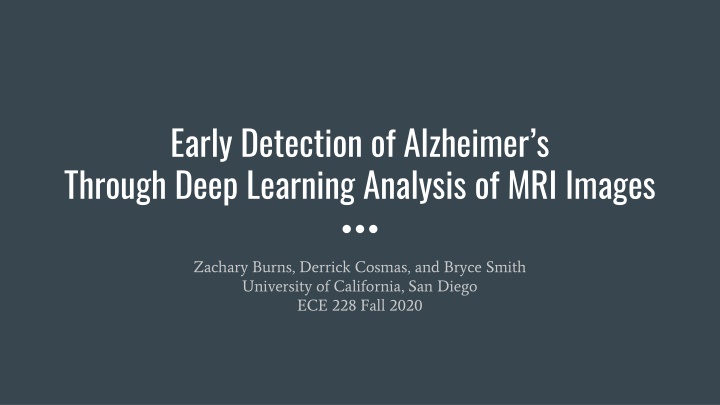
Deep Learning Analysis for Early Alzheimer's Detection
Explore how deep learning analysis of MRI images aids in early Alzheimer's detection. Learn about the research, detection methods, machine learning vs. deep learning, dataset used, and more. Early detection is crucial in the fight against Alzheimer's disease.
Uploaded on | 0 Views
Download Presentation

Please find below an Image/Link to download the presentation.
The content on the website is provided AS IS for your information and personal use only. It may not be sold, licensed, or shared on other websites without obtaining consent from the author. If you encounter any issues during the download, it is possible that the publisher has removed the file from their server.
You are allowed to download the files provided on this website for personal or commercial use, subject to the condition that they are used lawfully. All files are the property of their respective owners.
The content on the website is provided AS IS for your information and personal use only. It may not be sold, licensed, or shared on other websites without obtaining consent from the author.
E N D
Presentation Transcript
Early Detection of Alzheimers Through Deep Learning Analysis of MRI Images Zachary Burns, Derrick Cosmas, and Bryce Smith University of California, San Diego ECE 228 Fall 2020
44,000,000 Cases of Alzheimer s World Wide, Nearly 1 in 50 people in the US
Source: https://www.legacyhealth.org/health-services-and-information/health-services/for-adults-a-z/neurosciences/services-and-treatments/neurology/alzheimers-dementia.aspx Source:https://www.radiologyinfo.org/en/info.cfm?pg=alzheimers
Conventional Machine Learning Evaluating biomarkers from MRI - hippocampus volume Mapping structural changes in brain - hippocampus to cortical areas Multivariate approaches - SVM, PCA, structural equation modelling
Deep Learning ROI methods - combining multimodal features of PET and MRI scans in Deep NN Does not capture granular features in AD onsets 2D image slices of MRI trained on 2D - CNN 3D Convolution algorithms 3D Convolution with sparse AutoEncoders 3D MRI patches with feature patches from 3D CNN
Deep Learning vs Machine Learning Similar in many ways - features extraction and selection Machine Learning - mapping and examining brain structures Deep Learning - deeper feature capture and augmentation
Our Dataset We used a dataset taken from Kaggle ~ 5000 training images / 1200 test images labeled into 4 categories: -> Non Demented, Very Mild Demented, Mild Demented, Moderate Demented There were significant image differences between the datasets in the training and test datasets. We alleviated this problem by reshuffling and allocating the data verymildDem0.jpg verymildDem1790.jpg
Class Imbalances Training Training Testing Testing Percent Percent Not Demented Not Demented 2560 2560 640 640 50% 50% Very Mildly Demented Very Mildly Demented 448 448 1792 1792 35% 35% Mildly Demented Mildly Demented 717 717 179 179 14% 14% Moderately Demented Moderately Demented 12 12 52 52 1% 1%
Potential Models VGG16 VGG16 DenseNet DenseNet Inception(GoogLe Net) Inception(GoogLe Net) - Large convolutional NN - Dense blocks surrounded by conv and pooling layers - Includes Inception modules - Only has conv and pooling layers - Each module has multiple feature - Connects each layer to every other layer within the block - FC layers at the end can be trained for specific problems - Has fewer parameters than VGG16 -Model is relatively simple in construction - Encourages feature reuse - Very large number parameters - Has much fewer parameters
VGG16 Model Pre-Trained Model Takes in 224x224 images 13 convolution layers 5 pooling layers 2 dense relu 1 dense softmax Filters are 3x3 Source: https://neurohive.io/en/popular-networks/vgg16/
Our Approach: Transfer Learning - We used Keras Applications to load the VGG-16 model with pre-trained weights from ImagNet We removed the three FC output layers at the end of the model Next we added a new FC and output layer We experimented with modifying different parameters such as batch size, learning rate, optimizer, dropout, regularizers, and whether the convolutional layers were trainable Our main goal was to maximize both train and validation accuracy while preventing overfitting - - - -
References Shaikh, F. 10 Advanced Deep Learning Architectures Data Scientists Should Know! analyticsvidhya.com (2017) Szegedy, C., et al. Going Deeper with Convolutions CVPR (2015). Huang, G., et al. Densely Connected Convolutional Networks arXiv (2016) Szegedy, C. et al Rethinking the Inception Architecture for Computer Vision arXiv (2015) Wang C. et al Automatic recognition of mild cognitive impairment and Alzheimer's disease using ensemble based 3d densely connected convolutional networks. IEEE (2018)
Addressing Class Imbalances Combine the three classes of Very Mild, Mild and Moderate Demented into one class Demented Perform binary classification first to determine if an image is: Not-demented Demented Perform multi class classification to determine if an image in demented class is: Very Mildly Demented Mildly Demented Moderate demented
